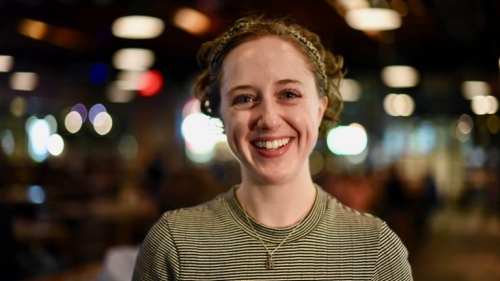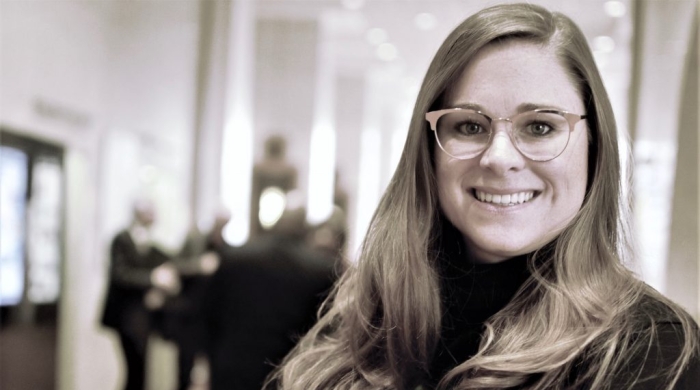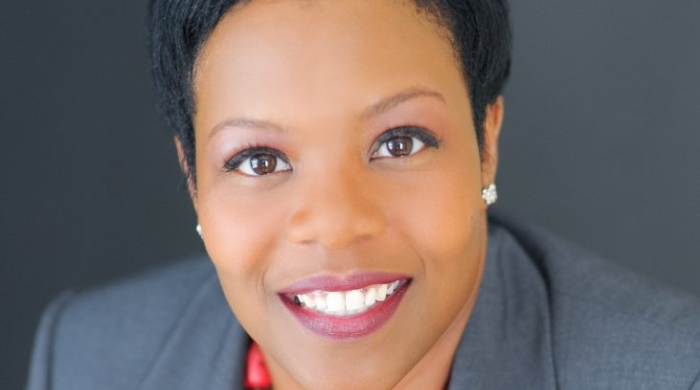
Meghan Crosby
Meghan Crosby (MA ’18) is a teacher, playwright, director, and choreographer. She earned a master’s degree from NYU Steinhardt in Educational Theatre K-12 Certification Track, and an MFA in playwriting and dramaturgy from the University of Glasgow, Scotland. She currently works as a drama teacher at Pine Street School, where she designs eight student performances per year. A graduate of Steinhardt’s educational theatre program, Meghan Crosby brings the art of social justice storytelling to school children in New York City.
Tell me about me about a typical day at school.
Each morning, as I ride the train from Brooklyn to Pine Street School, I put in my headphones — not to listen to the latest Mumford and Sons’ album or the New York Times’ ‘The Daily’ podcast, but to review choreography for the day.
I’m that goofy human on the subway who is dancing with her fingertips to the music. Sometimes, I am choreographing an upcoming musical, and sometimes I’m working on a dance created by my students. When I arrive at work, I greet my students at the door and then get ready for the day.
My morning classes are extra bubbly and bouncy because I start my day teaching two year-olds. We always start our toddler classes by singing a hello song in Spanish or Mandarin. Pine Street School is a trilingual international baccalaureate preschool and elementary school, so every classroom has one teacher who speaks English the entire day, and another who speaks the target language, which is Spanish or Mandarin, depending on the classroom.
I use a lot of folktales and fairytales with the twos. I interweave music with text and movement so we can bring our stories to life. We often embody animals as we act out our story and practice locomotor movements. One of my favorite songs to use for this exercise is “La Familia de Ranas,” (“The Frog Family”).
Next, I teach my older students, usually the second or third graders.
I am working with my second graders on a show about migration and the reasons why people move from one part of the world to another. The students are embodying three families from different countries who are fleeing their homes for reasons like war, lack of food and resources, and better job prospects.
My third graders are finishing up their “devising” process, meaning they have been collaboratively creating their own show. They used the text, “The Boy Who Harnessed the Wind” by Bryan Mealer and William Kamkwamba as inspiration for their own play.
Next we have Activity Choice Time (ACT) at Pine Street, which is a time when students choose from a plethora of physical and creative activities to enjoy before lunch.
Depending on the day of the week, I teach ballet, jazz/hip hop, yoga, or musical theatre. This is one of my favorite parts of the day because I get to work with a small group of passionate students who have chosen to explore a subject in depth.
After ACT and lunch, I teach the rest of the preschoolers. Like the twos, these three and four year-olds have a ton of frenetic energy, which makes them challenging, but silly and fun to work with. We explore story drama, an exercise in which we read a book and try to embody the characters both inside and beyond the text. We work a great deal on empathy by examining how the characters are feeling. As the year goes on, they begin to slowly understand how others feel by relating it back to their understanding of their own world.
At the end of the teaching day, I work with the kindergarteners and first graders. Right now, kindergarten is working on an adaptation of “Where the Wild Things Are.” First grade is practicing for a play about homes around the world, and how each one looks and works differently according to the place, culture, climate, and function. These kindergarten and first grade students mature so quickly, and it’s a thrill to see how much they change from the beginning of the year to the end.
The day closes with professional development in the afternoon. Depending on the day of the week, I meet with my fellow teachers to prepare for the students’ next unit or for an upcoming performance. As a teacher at an international baccalaureate school, I do my best to connect with the work my students are learning in the classroom. I also work closely with our music teacher and together we plan each grade’s winter and spring performance with help from the classroom teachers.
You got an MFA in playwriting in Scotland after completing your MA here at NYU, and have taught abroad. Tell me what you have learned from teaching educational theatre in different cultures.
One thing is certain, no matter where I’ve taught around the world, more often than not, children are much less inhibited than adults. Creativity and daring is natural to them.
Of course, I can’t generalize across all cultures, but in the places I’ve taught, namely the US, Scotland, China, and Madagascar, students are inquirers who see imaginary realities as extensions of their own world rather than separate from or contradictory to them.
ne of my favorite assignments was working with Zara Aina in Madagascar. Zara Aina means “share life” in Malagassy, and the students were willing to share everything with each other and with me. They wanted to learn anything and everything, and creativity and storytelling seemed to punctuate every word they spoke.
If there’s anything I’ve learned from teaching abroad, it’s to appreciate the beauty of language. I enjoy engaging in the nonverbal language of gesture, and that helped me get by in both China and Madagascar. I love fiddling with language as a playwright and teacher, and of course, I revel in acquiring new words and phrases I learned abroad.
One phrase I will never forget is “Manana namana,” which translates to “I have friends” in Malagasy. My last day teaching in Madagascar I kept repeating this phrase over and over to everyone I met at Zara Aina as my way of trying to express my gratitude for their friendship.
How did your degree at NYU prepare you for the classroom?
Before I went to NYU, I was an artist who happened to teach, but now I would say I am both an artist and a teacher. The professors at NYU offered such rich resources, and shared ideas for bring drama alive for students beyond the annual end-of-year performance.
I also learned about process drama and story drama, two techniques which help bring books and themes alive without the pressure of performance.
Although a great deal of teaching knowhow can only be acquired on your feet, I still learned so much from my master’s degree at NYU. There is a wonderful balance of philosophy and practice in the educational theatre program. Courses like Drama Education I and II provide you with a skeleton of what teaching theatre looks like, then the dramatic activities courses put the muscles on the framework so you have the strength to start moving and functioning as a teacher.
Related Articles
On Motherhood and Ethnographic Methods: An Interview with Doctoral Candidate, Chandler Patton Miranda
Chandler Patton Miranda is a doctoral candidate in NYU Steinhardt’s educational leadership program. She currently teaches Schooling in Diverse Communities to pre-service teachers at Queens College, City University of New York. Previously, she taught high school science on the southern United States border and in Colombia.
Laundromats Support Early Literacy, Finds NYU Steinhardt Professor
New research from Professor Susan Neuman finds that laundromats can serve as an important environment for early literacy development. The research was part of a program led by Laundry Literacy Coalition.
Helping Kids Learn and Lead: An Interview with Kaya Henderson; Former Chancellor, DC Schools
NYU Steinhardt kicked off its Dean’s Distinguished Lecture Series, with ‘What Will It Take?’, a talk by Kaya Henderson. Best known for the her role as former chancellor of the Washington, D.C. public schools, Henderson has worked for three decades in schools, school districts, and international communities.



